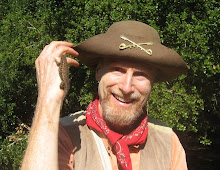

One of the most easily observed denizens of the Santa Cruz Mountains is a bright yellow mollusk which is the largest land slug in North America and one of the largest in the world.
Banana slugs glide through shady forests and along creek beds, eating almost anything organic, including leaves, animal droppings, and fungus. They have even been observed eating soap. They don't, however, eat redwood trees. Breaking off pieces of food with a rasping tongue that is covered with thousands of minute teeth, these slugs can eat several times their body weight each day.
You might wonder how such a slow, brightly-colored, unarmed, and utterly vulnerable-looking creature can survive in the wild. Looks are deceiving, because the banana slug has one very effective defense: slime. This slippery substance is essential for moisture retention and for traction and lubrication when moving; but it is also loaded with caustic and bitter-tasting chemicals that make it unappetizing to predators.
If you see two banana slugs intertwined, especially during the rainy season, you are probably witnessing a very exotic form of mating. These creatures are hermaphrodites, which means that each individual is both male and female. Two slugs fertilize each other during a 12-30 hour period and each leaves pregnant. Eggs are typically laid in the fall and hatch in the spring.
These slugs live about six years. On warm days during the dry season they constrict their bodies to a fraction of their crawling length and retreat into shady places, creek beds, and under logs to reduce dehydration. They thrive in areas of summer fog drip. On the right side of the slug is a breathing hole called a pneumostome. Two sensory tentacles each contain a timy eye.

